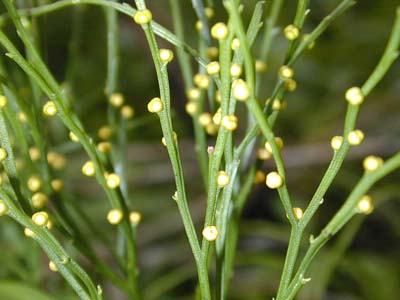- Psilotaceae
Taxobox
name = "Psilotaceae"

image_width = 250px
image_caption = Closeup of "Psilotum nudum"
regnum =Plant ae
divisio =Pteridophyta
classis =Psilotopsida
ordo = Psilotales
familia = Psilotaceae
subdivision_ranks = Genera
subdivision =
*"Psilotum "
*"Tmesipteris "Psilotaceae is a family of fern-like plants (in order Psilotales) consisting of two genera, "
Psilotum " and "Tmesipteris ". The two genera are very different and "Tmesipteris" has been proposed to belong in its own family, Tmesipteridaceae, but most classifications continue to treat it in Psilotaceae. The relationships of Psilotaceae have been unclear, in part because the plants lack roots or true leaves, but recent molecular systematic studies suggest a relationship to thefern familyOphioglossaceae .cite journal | last=Smith | first=Alan R.| coauthors= Kathleen M. Pryer, Eric Schuettpelz, Petra Korall, Harald Schneider, & Paul G. Wolf | year=2006 | title= A classification for extant ferns | url=http://www.pryerlab.net/publication/fichier749.pdf | format=PDF | journal=Taxon | volume= 55 | issue=3 | pages= 705–731 ]The first genus, "
Psilotum ", consists of small shrubby plants of the dry tropics commonly known as "Whisk ferns". The other genus, "Tmesipteris ", is anepiphyte found inAustralia ,New Zealand , andNew Caledonia . There has long been controversy about the relationships of the Psilotaceae, with some claiming that they arefern s (Pteridophyta), and others maintaining that they are descendants of the first vascular plants (thePsilophyta of theDevonian period). Recent evidence fromDNA demonstrates a much closer relationship to the ferns, and that they are closely related to theOphioglossales , in particular.All Psilotaceae share a few characteristics. They are
vascular plant s and they lack leaves, having instead small outgrowths called "enations". The enations are not considered true leaves because there is only a vascular bundle just underneath them, but not inside, as in leaves. Psilotales also do not have trueroot s. They are anchored byrhizoid s. Absorption is aided by symbiotic fungi calledmycorrhizae .Three sporangia are united into a "synangium", which is considered to be a very reduced series of branches. There is a thick tapetum to nourish the developing
spore s, as is typical of "eusporangiate" plants. Thegametophyte looks like a small piece of subterranean stem, but produces antheridia and archegonia.References
External links
* [http://www.ucmp.berkeley.edu/plants/pterophyta/psilotales.html Introduction to the Psilotales]
Wikimedia Foundation. 2010.
